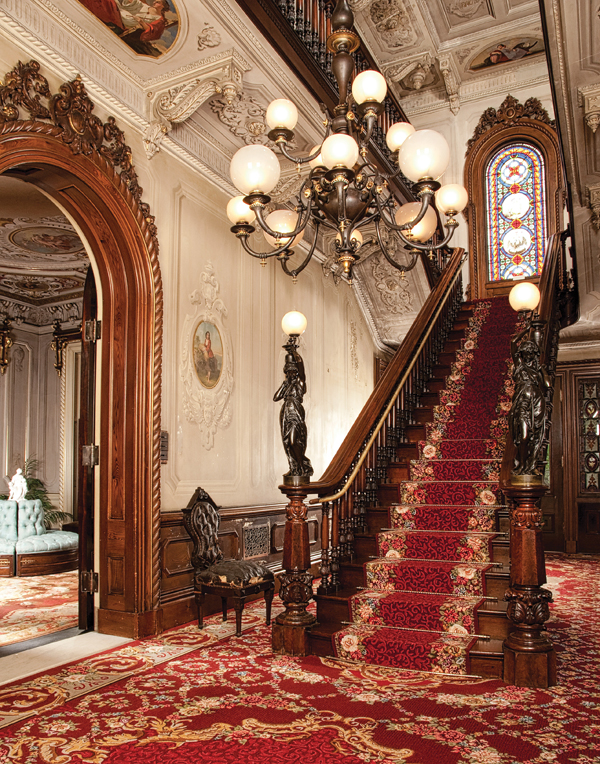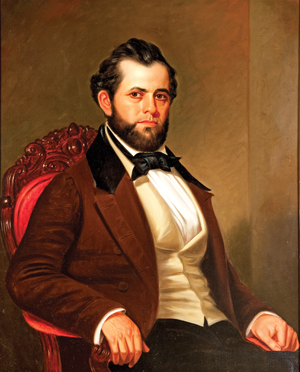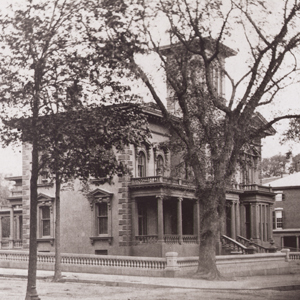 The Victoria Mansion’s incredibly ornate interiors remain largely intact.
The Victoria Mansion’s incredibly ornate interiors remain largely intact.
By Regina Cole | Photos courtesy Victoria Mansion It could be said that Maine truly became “Vacationland” in 1860, when Ruggles Sylvester Morse and his wife, Olive, first summered in their brand-new second home on Portland’s fashionable Danforth Street. When they erected the house that is now known as Victoria Mansion at a reputed cost of $70,000 to $100,000, the couple built Maine’s first summer home. He hailed from Leeds, Maine; she was from Durham, but they lived in New Orleans, where his fortune as a hotelier ascended to dizzying heights. “After they moved in for their first summer, the Civil War erupted,” said Arlene Palmer Schwind, curator of the house museum also known as the Morse-Libby House. “New Orleans was embargoed, and they didn’t come back to Maine until the summer of 1865.” Designed by Henry Austin, a New Haven, Connecticut, architect, the brownstone Italian villa has been notable since the Morses began building it in 1858. The local newspapers mentioned stages of its construction; Edward Hopper painted the house in 1927.
 A Maine native, Ruggles Sylvester
Morse made his fortune as the owner
of luxury hotels in New Orleans.
A Maine native, Ruggles Sylvester
Morse made his fortune as the owner
of luxury hotels in New Orleans.
Though the Herter Brothers designed the interiors of many homes of the rich and famous, Victoria Mansion was Gustave’s first whole-house commission. Now it stands as the only remaining testament to his genius.
Herter, who emigrated from Germany, was the adopted son of a skilled cabinetmaker. When he moved to New York, Gustave became the go-to man for craftsmanship, sophistication, and fashionable American interior design. After his brother, Christian, joined him in the New World, the immigrants founded an upholstery warehouse that became one of the first furniture making and interior decoration firms in the United States. Herter Brothers did it all, including decorative paneling and mantels, wall and ceiling decoration, patterned floors, carpets and draperies, and furniture so exquisitely made that the Metropolitan Museum of Art mounted a Herter Brothers exhibit in 1995. Though the brothers designed the interiors of many homes of the rich and famous, Victoria Mansion was Gustave’s first whole-house commission. Now it stands as the only remaining testament to his genius.
 Architect Henry Austin of New Haven,
Connecticut, was known for his Italianate
buildings, and the mansion (shown here
circa 1900) is widely recognized as the
most important expression of the Italian
villa style in American domestic architecture.
Architect Henry Austin of New Haven,
Connecticut, was known for his Italianate
buildings, and the mansion (shown here
circa 1900) is widely recognized as the
most important expression of the Italian
villa style in American domestic architecture.
Southern Comfort
The Morses weren’t swayed by temperance The Morses may have been Mainers, but they hung a portrait of Robert E. Lee just inside the kitchen door of their Maine summer house. One wonders how their Yankee friends and neighbors reacted. One wonders, too, what abolitionist New Englanders thought about the couple’s purchase of 23 slaves between 1846 and 1858. Though they sold them before the Civil War and there is no evidence that they ever brought them to Maine, Sylvester and Olive clearly lived like wealthy Southerners, not sober New Englanders. “In fact, when they installed a stained glass window depicting three Graces,” noted museum director Thomas Johnson, “Temperance was not one of them.” A neighbor just down the street was Neil Dow, known as “The Napoleon of Temperance” and “The Father of Prohibition.” Mayor of Portland, he also sponsored a bill making Maine the first dry state in the Union. The Morses were definitely not Prohibitionists; they kept a fully stocked cellar. “Most of the money made in the hotel trade was in bar receipts,” curator Schwind said. “The Morses believed in the positive power of alcohol.” The Libbys, however, did not. Staunch Prohibitionists, they poured out the contents of every bottle and barrel when they first moved into the house, which must have taken some time. But as frugal New Englanders, they did not destroy the stemware. It survives as testament to the lavish lifestyle of Maine’s first summer people.Magazine Issue #
Display Title
Maine’s First Summer Home
Secondary Title Text
Portland’s Victoria Mansion represents 19th-century opulence
Sections






